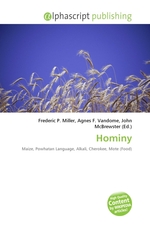Hominy
Frederic P. Miller, Agnes F. Vandome, John McBrewster
бумажная книга
Please note that the content of this book primarily consists of articles available from Wikipedia or other free sources online. Hominy or nixtamal is dried maize kernels which have been treated with an alkali. The English term hominy is derived from the Powhatan language word for maize. Many other Native American cultures also made hominy and integrated it into their diet. Cherokees, for example, made hominy grits by soaking corn in a weak lye solution obtained by leaching hardwood ash with water and beating it with a kanona, or corn beater. The grits were used to make a traditional hominy soup (called Gv-No-He-Nv A-Ma-Gi-i), a hominy soup that was allowed to ferment [Gv-Wi Si-Da A-Ma-Gi-i], cornbread, dumplings [Di-Gu-Nv-i], or, in post-contact times, fried with bacon and green onions. Some recipes using hominy include menudo (a spicy tripe and hominy soup), pozole or posole (a stew of hominy and pork, chicken, or other meat), hominy bread, hominy chili, hog n' hominy, casseroles and fried dishes. Hominy can be ground coarsely to make hominy grits, or into a fine mash (dough) to make masa, a dough used regularly in Latin American cuisine.
Данное издание не является оригинальным. Книга печатается по технологии принт-он-деманд после получения заказа.


